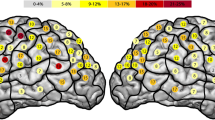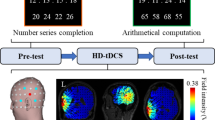Abstract
Concerning calculation function, studies have already reported on localizing computational function in patients and volunteers by functional magnetic resonance imaging and transcranial magnetic stimulation. However, the development of accurate repetitive navigated TMS (rTMS) with a considerably higher spatial resolution opens a new field in cognitive neuroscience. This study was therefore designed to evaluate the feasibility of rTMS for locating cortical calculation function in healthy volunteers, and to establish this technique for future scientific applications as well as preoperative mapping in brain tumor patients. Twenty healthy subjects underwent rTMS calculation mapping using 5 Hz/10 pulses. Fifty-two previously determined cortical spots of the whole hemispheres were stimulated on both sides. The subjects were instructed to perform the calculation task composed of 80 simple arithmetic operations while rTMS pulses were applied. The highest error rate (80 %) for all errors of all subjects was observed in the right ventral precentral gyrus. Concerning division task, a 45 % error rate was achieved in the left middle frontal gyrus. The subtraction task showed its highest error rate (40 %) in the right angular gyrus (anG). In the addition task a 35 % error rate was observed in the left anterior superior temporal gyrus. Lastly, the multiplication task induced a maximum error rate of 30 % in the left anG. rTMS seems feasible as a way to locate cortical calculation function. Besides language function, the cortical localizations are well in accordance with the current literature for other modalities or lesion studies.







Similar content being viewed by others
Abbreviations
- aMTG:
-
Anterior middle temporal gyrus
- anG:
-
Angular gyrus
- ANOVA:
-
Analysis of variance
- aSTG:
-
Anterior superior temporal gyrus
- BOLD-fMRI:
-
Blood oxygen level dependent functional magnetic resonance imaging
- CI:
-
Confidence intervals
- CPS:
-
Cortical parcellation system
- DCS:
-
Direct cortical stimulation
- EMG:
-
Electromyogram
- fMRI:
-
Functional magnetic resonance imaging
- hIPS:
-
Horizontal segment of the IPS
- IPI:
-
Inter-picture interval
- IPS:
-
Intraparietal sulcus
- ITG:
-
Inferior temporal gyrus
- MEP:
-
Motor evoked potential
- MFG:
-
Middle frontal gyrus
- mMFG:
-
Middle middle frontal gyrus
- nTMS:
-
Navigated transcranial magnetic stimulation
- oplFG:
-
Opercular inferior frontal gyrus
- OR:
-
Odds ratio
- orIFG:
-
Orbital part of the inferior frontal gyrus
- pMFG:
-
Posterior middle frontal gyrus
- pMTG:
-
Posterior middle temporal gyrus
- polIFG:
-
Polar inferior frontal gyrus
- polMFG:
-
Polar middle frontal gyrus
- polSFG:
-
Polar superior frontal gyrus
- polSTG:
-
Polar superior temporal gyrus
- PSPL:
-
Posterior superior parietal lobule
- pSTG:
-
Posterior superior temporal gyrus
- PTI:
-
Picture-to-trigger interval
- rMT:
-
Resting motor threshold
- rTMS:
-
Repetitive navigated transcranial magnetic stimulation
- TMS:
-
Transcranial magnetic stimulation
- VAS:
-
Visual analogue scale
- vPrG:
-
Ventral precentral gyrus
References
Andres M, Pelgrims B, Michaux N, Olivier E, Pesenti M (2011) Role of distinct parietal areas in arithmetic: an fMRI-guided TMS study. Neuroimage 54(4):3048–3056. doi:10.1016/j.neuroimage.2010.11.009
Arsalidou M, Taylor MJ (2011) Is 2 + 2 = 4? Meta-analyses of brain areas needed for numbers and calculations. Neuroimage 54(3):2382–2393. doi:10.1016/j.neuroimage.2010.10.009 S1053-8119(10)01301-7 [pii]
Baptiste DC, Fehlings MG (2006) Pathophysiology of cervical myelopathy. Spine J 6(6 Suppl):190S–197S. doi:10.1016/j.spinee.2006.04.024 S1529-9430(06)00222-1 [pii]
Barker AT, Jalinous R, Freeston IL (1985) Non-invasive magnetic stimulation of human motor cortex. Lancet 1(8437):1106–1107 S0140-6736(85)92413-4 [pii]
Benn Y, Zheng Y, Wilkinson ID, Siegal M, Varley R (2012) Language in calculation: a core mechanism? Neuropsychologia 50(1):1–10. doi:10.1016/j.neuropsychologia.2011.09.045
Berger H (1926) Über Rechenstörungen bei Herderkrankungen des Großhirns. Archiv f Psychiatrie 78(1):238–263. doi:10.1007/BF01996620
Campbell JI, Graham DJ (1985) Mental multiplication skill: structure, process, and acquisition. Can J Psychol/Revue canadienne de psychologie 39(2):338–366. doi:10.1037/h0080065
Cohen L, Dehaene S, Chochon F, Lehéricy S, Naccache L (2000) Language and calculation within the parietal lobe: a combined cognitive, anatomical and fMRI study. Neuropsychologia 38(10):1426–1440. doi:10.1016/S0028-3932(00)00038-5
Corina DP, Gibson EK, Martin R, Poliakov A, Brinkley J, Ojemann GA (2005) Dissociation of action and object naming: evidence from cortical stimulation mapping. Hum Brain Mapp 24(1):1–10. doi:10.1002/hbm.20063
Dehaene S, Spelke E, Pinel P, Stanescu R, Tsivkin S (1999) Sources of mathematical thinking: behavioral and brain-imaging evidence. Science 284(5416):970–974
Dehaene S, Piazza M, Pinel P, Cohen L (2003) Three parietal circuits for number processing. Cognit Neuropsychol 20:487–506
Delazer M, Girelli M, Grana´ A, Domahs F (2003) Number processing and calculation—normative data from healthy adults. Clin Neuropsychol 17:331–350
Della Puppa A, De Pellegrin S, d’Avella E, Gioffre G, Munari M, Saladini M, Salillas E, Scienza R, Semenza C (2013) Right parietal cortex and calculation processing: intraoperative functional mapping of multiplication and addition in patients affected by a brain tumor. J Neurosurg 119(5):1107–1111. doi:10.3171/2013.6.JNS122445
Duffau H, Denvil D, Lopes M, Gasparini F, Capelle L, Van Effenterre R (2002) Intraoperative mapping of the cortical areas involved in multiplication and subtraction: an electrostimulation study in a patient with left parietal glioma. J Neurol Neurosurg Psychiatry 73:733–738. doi:10.1136/jnnp.73.6.733
Epstein CM (1998) Transcranial magnetic stimulation: language function. J Clin Neurophysiol 15(4):325–332
Epstein CM, Lah JJ, Meador K, Weissman JD, Gaitan LE, Dihenia B (1996) Optimum stimulus parameters for lateralized suppression of speech with magnetic brain stimulation. Neurology 47(6):1590–1593
Fehr T, Code C, Herrmann M (2007) Common brain regions underlying different arithmetic operations as revealed by conjunct fMRI-BOLD activation. Brain Res 1172:93–102. doi:10.1016/j.brainres.2007.07.043 S0006-8993(07)01745-3 [pii]
Frey D, Schilt S, Strack V, Zdunczyk A, Rosler J, Niraula B, Vajkoczy P, Picht T (2014) Navigated transcranial magnetic stimulation improves the treatment outcome in patients with brain tumors in motor eloquent locations. Neuro Oncol 16(10):1365–1372. doi:10.1093/neuonc/nou110
Gruber O, Indefrey P, Steinmetz H, Kleinschmidt A (2001) Dissociating neural correlates of cognitive components in mental calculation. Cereb Cortex 11(4):350–359. doi:10.1093/cercor/11.4.350
Ilmoniemi RJ, Ruohonen J, Karhu J (1999) Transcranial magnetic stimulation-a new tool for functional imaging of the brain. Crit Rev Biomed Eng 27(3–5):241–284
Kadosh RC, Kadosh KC, Schuhmann T, Kaas TA, Goebel R, Henik A, Sack AT (2007) Virtual dyscalculia induced by parietal-lobe TMS impairs automatic magnitude processing. Curr Biol 17(8):689–693. doi:10.1016/j.cub.2007.02.056
Kawashima R, Taira M, Okita K, Inoue K, Tajima N, Yoshida H, Sasaki T, Sugiura M, Watanabe J, Fukuda H (2004) A functional MRI study of simple arithmetic—a comparison between children and adults. Brain Res Cognit Brain Res 18(3):227–233
Krieg SM, Buchmann NH, Gempt J, Shiban E, Meyer B, Ringel F (2012a) Diffusion tensor imaging fiber tracking using navigated brain stimulation—a feasibility study. Acta Neurochir (Wien) 154(3):555–563. doi:10.1007/s00701-011-1255-3
Krieg SM, Shiban E, Buchmann N, Gempt J, Foerschler A, Meyer B, Ringel F (2012b) Utility of presurgical navigated transcranial magnetic brain stimulation for the resection of tumors in eloquent motor areas. J Neurosurg 116(5):994–1001. doi:10.3171/2011.12.JNS111524
Krieg SM, Sollmann N, Hauck T, Ille S, Foerschler A, Meyer B, Ringel F (2013) Functional language shift to the right hemisphere in patients with language-eloquent brain tumors. PLoS One 8(9):e75403. doi:10.1371/journal.pone.0075403
Krieg SM, Sabih J, Bulubasova L, Obermueller T, Negwer C, Janssen I, Shiban E, Meyer B, Ringel F (2014a) Preoperative motor mapping by navigated transcranial magnetic brain stimulation improves outcome for motor eloquent lesions. Neuro-oncology. doi:10.1093/neuonc/nou007
Krieg SM, Tarapore PE, Picht T, Tanigawa N, Houde J, Sollmann N, Meyer B, Vajkoczy P, Berger MS, Ringel F, Nagarajan S (2014b) Optimal timing of pulse onset for language mapping with navigated repetitive transcranial magnetic stimulation. Neuroimage 100:219–236. doi:10.1016/j.neuroimage.2014.06.016
Lampl Y, Eshel Y, Gilad R, Sarova-Pinhas I (1994) Selective acalculia with sparing of the subtraction process in a patient with left parieto-temporal hemorrhage. Neurology 44:1759–1761
Lewadovsky M, Stadelmann E (1908) Über einen bemerkenswerten Fall von Hirnblutung und über Rechenstörungen bei Herderkrankungen des Gehirns. Zeitschrift für Neurologie und Psychiatrie 2:249–265
Lioumis P, Zhdanov A, Makela N, Lehtinen H, Wilenius J, Neuvonen T, Hannula H, Deletis V, Picht T, Makela JP (2012) A novel approach for documenting naming errors induced by navigated transcranial magnetic stimulation. J Neurosci Methods 204(2):349–354. doi:10.1016/j.jneumeth.2011.11.003
McGraw P, Mathews VP, Wang Y, Phillips MD (2001) Approach to functional magnetic resonance imaging of language based on models of language organization. Neuroimag Clin N Am 11(2):343–353
Pascual-Leone A, Gates JR, Dhuna A (1991) Induction of speech arrest and counting errors with rapid-rate transcranial magnetic stimulation. Neurology 41(5):697–702
Pesenti M, Seron X, Van der Linden M (1994) Selective impairment as evidence for mental organisation of arithmetic facts: BB, a case of preserved subtraction? Cortex 30:661–671
Picht T, Mularski S, Kuehn B, Vajkoczy P, Kombos T, Suess O (2009) Navigated transcranial magnetic stimulation for preoperative functional diagnostics in brain tumor surgery. Neurosurgery 65(6 Suppl):93–98
Picht T, Krieg SM, Sollmann N, Rosler J, Niraula B, Neuvonen T, Savolainen P, Lioumis P, Makela JP, Deletis V, Meyer B, Vajkoczy P, Ringel F (2013) A comparison of language mapping by preoperative navigated transcranial magnetic stimulation and direct cortical stimulation during awake surgery. Neurosurgery 72(5):808–819. doi:10.1227/NEU.0b013e3182889e01
Price CJ, Friston KJ (2002) Degeneracy and cognitive anatomy. Trends Cognit Sci 6(10):416–421. doi:10.1016/S1364-6613(02)01976-9
Pu S, Li YN, Wu CX, Wang YZ, Zhou XL, Jiang T (2011) Cortical areas involved in numerical processing: an intraoperative electrostimulation study. Stereotact Funct Neurosurg 89(1):42–47. doi:10.1159/000321186
Rossi S, Hallett M, Rossini PM, Pascual-Leone A (2009) Safety, ethical considerations, and application guidelines for the use of transcranial magnetic stimulation in clinical practice and research. Clin Neurophysiol 120(12):2008–2039. doi:10.1016/j.clinph.2009.08.016 S1388-2457(09)00519-7 [pii]
Ruohonen J, Ilmoniemi RJ (1999) Modeling of the stimulating field generation in TMS. Electroencephalogr Clin Neurophysiol Suppl 51:30–40
Rusconi E, Walsh V, Butterworth B (2005) Dexterity with numbers: rTMS over left angular gyrus disrupts finger gnosis and number processing. Neuropsychologia 43(11):1609–1624. doi:10.1016/j.neuropsychologia.2005.01.009
Sanai N, Martino J, Berger MS (2012) Morbidity profile following aggressive resection of parietal lobe gliomas. J Neurosurg 116(6):1182–1186. doi:10.3171/2012.2.JNS111228
Sollmann N, Hauck T, Obermuller T, Hapfelmeier A, Meyer B, Ringel F, Krieg SM (2013a) Inter- and intraobserver variability in motor mapping of the hotspot for the abductor policis brevis muscle. BMC Neurosci 14(1):94. doi:10.1186/1471-2202-14-94 1471-2202-14-94 [pii]
Sollmann N, Picht T, Makela JP, Meyer B, Ringel F, Krieg SM (2013b) Navigated transcranial magnetic stimulation for preoperative language mapping in a patient with a left frontoopercular glioblastoma. J Neurosurg 118(1):175–179. doi:10.3171/2012.9.JNS121053
Tarapore PE, Tate MC, Findlay AM, Honma SM, Mizuiri D, Berger MS, Nagarajan SS (2012) Preoperative multimodal motor mapping: a comparison of magnetoencephalography imaging, navigated transcranial magnetic stimulation, and direct cortical stimulation. J Neurosurg 117(2):354–362. doi:10.3171/2012.5.JNS112124
Tarapore PE, Findlay AM, Honma SM, Mizuiri D, Houde JF, Berger MS, Nagarajan SS (2013) Language mapping with navigated repetitive TMS: proof of technique and validation. Neuroimage 82:260–272. doi:10.1016/j.neuroimage.2013.05.018 S1053-8119(13)00512-0 [pii]
Van Honk J, Schutter DJLG (2004) Transcranial magnetic stimulation and processing of facial threats. Am J Psychiatry 161(5):928. doi:10.1176/appi.ajp.161.5.928
Warrington EK (1982) The fractionation of arithmetical skills: a single case study. Q J Exp Psychol 34(Pt 1):31–51
Wassermann EM, Blaxton TA, Hoffman EA, Berry CD, Oletsky H, Pascual-Leone A, Theodore WH (1999) Repetitive transcranial magnetic stimulation of the dominant hemisphere can disrupt visual naming in temporal lobe epilepsy patients. Neuropsychologia 37(5):537–544 S002839329800102X [pii]
Author information
Authors and Affiliations
Corresponding author
Ethics declarations
Conflict of interest
S.K. is a consultant for BrainLAB AG (Feldkirchen, Germany). All other authors declare that they have no conflict of interest concerning this current study. The study was completely financed by institutional grants of the Department of Neurosurgery and the Section of Neuroradiology. The authors report no conflict of interest affecting the materials or methods used in this study or the findings specified in this paper.
Rights and permissions
About this article
Cite this article
Maurer, S., Tanigawa, N., Sollmann, N. et al. Non-invasive mapping of calculation function by repetitive navigated transcranial magnetic stimulation. Brain Struct Funct 221, 3927–3947 (2016). https://doi.org/10.1007/s00429-015-1136-2
Received:
Accepted:
Published:
Issue Date:
DOI: https://doi.org/10.1007/s00429-015-1136-2




